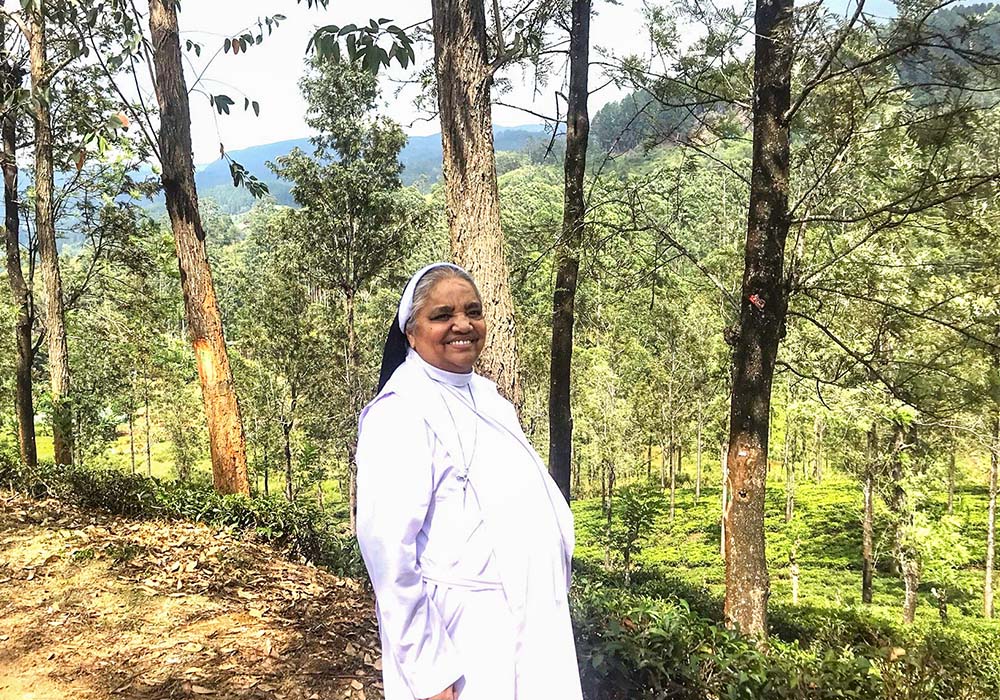Questions and answers with Sister Maria Amali about her religious journey in the midst of the civil war in Sri Lanka

Sr. Maria Amali of the Apostolic Carmel worked as a crisis manager during the three-decade-long civil war in northern Sri Lanka, especially in the areas of Mannar, Jaffna and Batticaloa. During the war, she found herself in life-threatening situations on several occasions.
The civil war between separatist Tamil militants and the Sri Lankan government between 1983 and 2009 is estimated to have killed over 100,000 people. During this period, the tsunami that hit the coast of Sri Lanka on December 26, 2004, claimed over 30,000 lives and left thousands homeless.
Amali helped survivors of the 2004 tsunami and gathered a group of volunteers to help bury 220 people who died in the tsunami near her monastery in a coastal village.
Amali, who was diagnosed with abdominal cancer in 2017, celebrated her 40th anniversary in the order on April 12. Regardless of her illness, she looks after the workers on the tea plantations.
In April, she shared her crisis management mission with the Global Sisters Report.
_____
GSR: You joined the Order when there was a civil war in your country. What was your inspiration?
Amali: My vocation has nothing to do with the civil war, since I entered the monastery before the war began. However, when I made my final vows in 1984, the war had already begun.
My first assignment was in a conflict zone, so you could say I lived my religious journey among war victims on the battlefield. I lived my religious life for 26 years in the war zones and even after the war.
Have you ever thought about escaping to a safer place?
No. I was determined to continue in the war zone even after I was seriously wounded while trying to help some of the victims. I also narrowly escaped artillery and shelling on several occasions. I cared for the wounded on both sides – Sinhalese and Tamil. I firmly believe that God called me to this ministry.
Please describe in more detail how you were injured.
It was an accident during a visit to a makeshift prison where our boys were being tortured for alleged links with the LTTE (Liberation Tigers of the Tamil Eelam). I handed over the boys’ identity cards to the officials and drove back with them in an open tractor. On the way, the firing started. The driver stopped the tractor and then suddenly accelerated to avoid the firing. But I lost my balance and fell, sustaining a spinal cord injury.
After four months of intensive treatment, I returned to my monastery and resumed my work among the surviving villagers.
The Sinhala army, who respected Catholic nuns, advised me several times to go south where it was relatively safe. Even my sisters advised me against it. But I stayed there. At one point my condition became critical due to brain malaria, but after fighting for my life in the hospital for 35 days, God saved me.
You are a Tamil. Did the government authorities, which are predominantly Sinhalese, suspect that you had links with the LTTE?
I don’t think so. I was one of the few nuns on the front line, caring for the wounded regardless of their ethnicity. Both the Sinhala and Tamil groups respected me. Several young Sinhala people who were forcibly recruited into the army died in battle. I was there to offer them water before they died.
What influence did the war and suffering have on your religious life?
I always had the image of Christ crucified and Mother Mary in my mind and drew courage and inspiration from them on the battlefield. I could have been killed in the war, but I believe God saved me so that I could serve others.
I have always trusted in God’s providence and guidance. Without God’s protection, I would not have survived 26 years on the battlefield. I was able to live my religious life to the fullest even when I was hungry, sick, and experiencing real poverty. Soldiers always risk their lives on the battlefield. Mine was no exception.
In addition to caring for war victims and their families, you also served the dead.
That’s right! On the battlefields we see the wounded and the dead. I attended the funerals of several victims who died in bombings, suicide attacks or artillery fire. I knew several victims and was frustrated.
One day, a Hindu woman came running to our monastery and asked me to come to her village, which was surrounded by the armed forces. She trusted me so much that I could not refuse her. By the time I reached the village, 13 people had been killed, including some of her family members.
As I knelt down to pray for the dead, I heard them shouting, “Lie down, lie down.” Another volley began. When I turned around, I saw to my horror the woman collapsed. A bullet had severed her head. I cried like a little child as I picked up her body.
Another shock came during the tsunami. The deadly waves killed hundreds of people around our monastery. I personally buried nearly 220 people, mostly Hindus.
Could you explain the tsunami spill in more detail?
The tsunami hit Sri Lanka, which was already suffering from civil war. At least 30,000 people died in Sri Lanka, most of them on the northern coasts, where the civil war continued to rage.
Our monastery was not far from the shore, but God spared us so that we could bury the dead. With the help of some local boys, we coordinated the burial of the dead with government officials and volunteers. We transported the bodies to the mass graves using tractors and small vehicles.
We didn’t know their religion. But people wanted me to pray and perform their last rites. A body resembled my father and I was shocked. My father, however, was safe at home.
How do you cope with such extreme stress situations?
I really don’t know. But I was sure that God was always with me and gave me courage, strength and self-confidence to do the impossible. My religious clothes and the crucifix hanging around my neck and the rosary in my pocket protected me from all dangers and gave me the confidence to go on.
Did the tsunami have an impact on the civil war?
The tsunami hit both Tamil militants and government troops. It also exacerbated the country’s already fragile economic, emotional and legal situation. But it did not cool the war spirit. Some of the bloodiest conflicts took place after the tsunami. After 2004, the war killed almost three times as many people as the tsunami.
The war ended in 2009 with the massacre, which included the LTTE leader (Velupillai) Prabhakaran, his son and anyone the government considered a threat. I did not die in the war, but death is now haunting me in the form of cancer. But I am not afraid.
After all you have done for others, are you angry at God because of cancer?
No. It has been a journey with God my whole life. This cancer has not taken me away from my Lord, but has brought me closer to Him.
I have been receiving treatment since my diagnosis in 2017. My pain is nothing compared to the suffering of ordinary people in war zones or the victims of natural disasters. I always look up to the crucified Christ.
I have undergone some surgeries and laser therapy. I have been shifted to our Eastern Province where it is comparatively cooler. I continue my work for the oppressed, especially the workers in the tea plantations. I will work as long as I live.
Tell us about your family. Why did you join the Apostolic Carmel?
My ancestors came from India several centuries ago, long before the British brought workers for their tea plantation. 18 members of my family have joined the consecrated life. Five of them are in the Congregation of the Apostolic Carmel. Another nine are in congregations such as the Holy Family, Holy Cross, Sisters of Mercy and so on. We also have four priests. So it is a blessed family, close to God.



